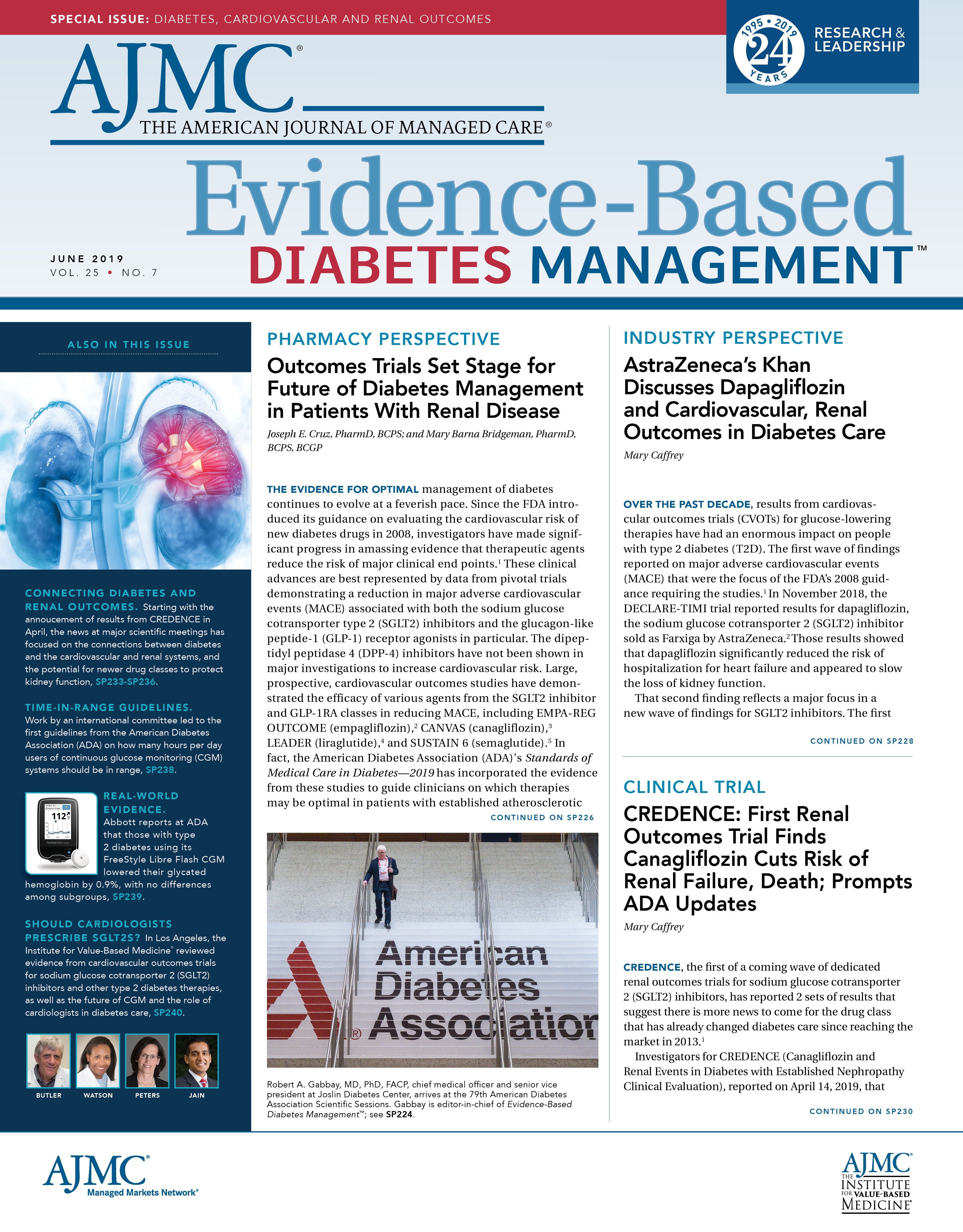- Center on Health Equity & Access
- Clinical
- Health Care Cost
- Health Care Delivery
- Insurance
- Policy
- Technology
- Value-Based Care
From the Editor-in-Chief: Evolving Role of T2D Therapy, From Secondary to Primary Prevention
Evidence that newer type 2 diabetes therapies offer cardiovasular and renal benefits offer opportunities for greater collaboration among specialists and more value for patients. Payers must take notice.
Cardiovascular disease (CVD) IS the leading cause of death in the world, and the top killer of those with diabetes. Having diabetes doubles the risk of death from CVD, and women are at particularly high risk.
Despite this, for years a diabetes drug was measured by only its ability to lower blood glucose. Cholesterol-lowering statins or angiotensin converting enzyme inhibitors that controlled blood pressure did the heavy lifting in management of cardiovascular (CV) risk. But over the past decade, we have seen a paradigm shift, not only in what we can expect from a diabetes therapy, but also in our knowledge that drugs developed for diabetes could be used to treat other complications, or even prevent them from happening in the first place.
The shift began in 2008, when FDA declared that the old definition of success—lowering glycated hemoglobin (A1C)—was not enough for the next wave of
diabetes drugs. Under a new guidance, the test would include outcomes: is a drug safe? Can we be certain that a person taking the drug is not more likely to have
a heart attack or stroke?
We welcomed the unexpected news: drugs in 2 classes—the sodium glucose co-transporter 2 (SGLT2) inhibitors and glucagon-like peptide-1 (GLP-1) receptor agonists—could, in some cases, reduce CV events and even death. But there was also evidence that the SGLT2 inhibitors, in particular, could reduce the risk of hospitalization for heart failure and renal decline.
As it became clear these diabetes drugs might slow the loss of losing kidney function, a new wave of outcomes trials began—this time to examine the drugs’ potential in primary prevention. A drug developed for one purpose—to control blood glucose and lower A1C—might be used to keep patients from developing diabetic kidney disease, which affects about 1 in 4 people with diabetes, or from progressing to dialysis, one of the most expensive and debilitating conditions in all of healthcare. The first of the renal outcomes trials, CREDENCE, reported in April that the SGLT2 inhibitor canagliflozin reduced the risk of renal failure and death by 30% in patients with type 2 diabetes (T2D) and chronic kidney disease (CKD).1 At the American Diabetes Association (ADA) Scientific Sessions this month, held in San Francisco, California, results from the REWIND trial showed that the GLP-1 receptor agonist dulaglutide reduced CV events 12% and showed renal benefits in a cohort that for the first time included a large primary prevention population.2
When viewed with other trial results and real-world data, these findings open doors for collaboration among endocrinologists, cardiologists and nephrologists, to vastly improve the prospects for those at risk of diabetic kidney disease. This will deepen the ties between ADA and the American College of Cardiology (ACC), which have jointly endorsed guidelines on the use of SGLT2 inhibitors and GLP-1 receptor agonists for patients who have CV risk and T2D.
The challenge now is getting payers to embrace the evidence. Because of increased obesity, the numbers with CKD had been projected to rise, but these new
results suggest the trend can be slowed or even reversed, if the right patients receive the right drugs. Unfortunately, new diabetes drugs are reaching only a fraction of patients who could benefit. Survey results reported at the 2018 ADA Scientific Sessions showed 28% of physicians said their patients were unable to start new diabetes therapy, and SGLT2 inhibitors in particular, due to cost.
Collaboration between ADA and ACC, and the recent joint session between ADA and the American Society of Nephrology in San Francisco show that specialists
are ready work together in the cause of prevention. It’s time for reimbursement to keep pace with the science, both to help patients and to prevent unnecessary
spending years from now. Dr Gabbay is senior vice president and chief medical officer at Joslin Diabetes Center. He is editor-in-chief of Evidence-Based Diabetes Management.References
1. Perkovic V, Jardine MJ, Neal B, et al; CREDENCE Trial Investigators. Canagliflozin and renal outcomes in type 2 diabetes and nephropathy. N Engl J
Med. 2019;380(24):2295-2306. doi: 10.1056/NEJMoa1811744.
2. Gerstein HC, Colhoun HM, Dagenals GR, et al. Dulaglutide and cardiovascular outcomes in type 2 diabetes (REWIND): a double-blind, randomized
placebo-controlled trial [published June 9, 2019]. Lancet Diab Endrocrinol. :doi.org/10.1016/S0140-6736(19)31149-3.

HEDIS Glycemic Goal Achieved Using Control-IQ Technology
December 22nd 2025A greater proportion of patients with type 1 diabetes who used automated insulin delivery systems vs multiple daily injections achieved the Healthcare Effectiveness Data and Information Set (HEDIS) glycemic measure.
Read More
What It Takes to Improve Guideline-Based Heart Failure Care With Ty J. Gluckman, MD
August 5th 2025Explore innovative strategies to enhance heart failure treatment through guideline-directed medical therapy, remote monitoring, and artificial intelligence–driven solutions for better patient outcomes.
Listen
Performance of 2-Stage Health-Related Social Needs Screening Using Area-Level Measures
December 19th 2025Limiting health-related social needs screening to lower-income areas would reduce screening burdens; however, this study found a 2-stage screening approach based on geography to be suboptimal.
Read More

